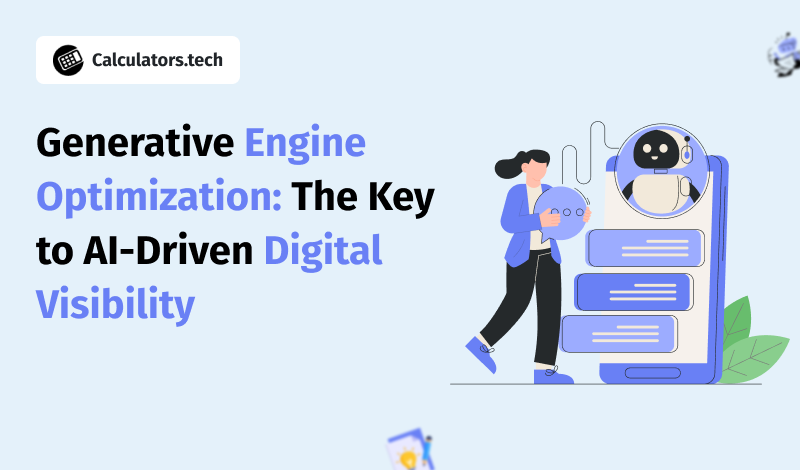Search has changed, once again, but it’s not just another tweak in the algorithm or some new SERP layout. It’s the shift to AI-based search engines, and it's probably the biggest revolution in the history of SEO services so far. And with tools like ChatGPT, Google SGE, and Perplexity AI shaping what’s visible (and not), digital visibility isn’t about ranking on page one. It’s about being selected, summarized, and served up by a generative engine.
This new land requires a new tactic – Generative Engine Optimization (GEO). No more old-style keyword stuffing or chasing after backlinks will do. Instead, what is required is that marketers and content creators learn how to give these AI systems the right signals, structure, and substance to feed. It’s high time if you want your content to land in AI-driven answers, recommendations, or citations.
Here are some of the most crucial tactics for GEO – the evolution of SEO into its next form.

Brush up on the basics of GEO
Let’s start with what generative engines are. Unlike traditional search engines that return a list of links, generative engines create answers based on a mixture of indexed content and learned data. They're built to respond, not redirect. That shift changes everything about how your content gets seen—or doesn’t.
Search used to be about climbing up to the top ten results. Now, it’s about getting included in the single answer that a generative engine outputs. It’s no longer just about being optimized for crawling and indexing. It’s about being useful enough for AI to reference directly in its response.
Getting there requires an understanding of how AI chooses what to show. You need to write in a way that makes your content easy to summarize, quote, or blend into broader answers. If you’re unsure where to begin, the generative engine optimization guide by Skale offers a solid starting point.
And yes, things like backlinks and keywords still matter. But now, it’s about how your page contributes to the AI’s overall understanding of a topic. It’s about offering clarity, credibility, and structure so your words aren’t just searchable—they’re reusable by the engine itself. That's the core shift GEO introduces.
People already trust AI more than you think
It’s not just tech enthusiasts who are using generative AI tools—regular users are doing it too, and they’re doing it a lot. Instead of typing questions into Google, they’re asking ChatGPT directly. They want straight answers, fast, without digging through ten blue links or dodging SEO-heavy filler. That change speaks volumes.
For instance, if someone is preparing to apply for a job, they might ask ChatGPT for advice on what to include in their application before even opening LinkedIn. They can then fine-tune it with the resume AI tool by Rezi to feel completely guided and efficient through the whole process. It’s not a search engine query, though; it’s all generative.
That’s the real shift: not a fight against this wave of search but an embrace of it. The use of such tools by users as everyday companions marks that the transition from traditional to non-traditional search is underway in practice, not just in theory.
Just take an example of how, in other everyday moments, people rely on AI tools for tasks such as creating social media captions, planning posts, or even suggesting hashtags. The trust in AI’s output has grown to a point where users lean on it for personal and professional communication alike. They’re no longer asking Google for advice—they’re asking an AI assistant to do the task directly.
Structured content wins in the AI age
When a generative engine tries to decide what to pull into an answer, it favors structure. A clean layout with headings, subheadings, and lists makes the content easier to parse, summarize, and reuse. You’re not just writing for humans anymore—you’re writing for machines that need clarity to be confident.
A good list or FAQ section doesn’t just help the reader skim—it gives AI models bite-sized facts they can pull directly. These sections are far more likely to show up in answers, recaps, and outlines generated by AI. In many cases, they’re exactly what the model needs to complete a helpful, relevant response.
HTML markup like schema is often overlooked, but in this context, it still matters. Structured data helps AI understand what role your content plays—whether it’s a recipe, a product review, or a how-to guide. That understanding boosts your chances of showing up in the AI’s output.
Lastly, think of structure as a trust signal. A well-organized article is more likely to be interpreted correctly. And when AI feels confident about what you’re saying, it’s far more likely to include you in the final answer. That’s where visibility comes from in this new search environment.
Authority and reputation still count, just differently
You don’t have to rank first to show up on a search engine, but you do have to be antagonistic. If AI systems pick up your content, which is quoted by credible sources, that will increase the likelihood of you being cited in responses. Authority is now a part of the conversation, not just dominating SERPs.
Backlinks don’t tell the whole story. Now, it’s all about co-occurrence, the frequency at which your brand or content appears in relevant contexts. AI tools have learned to identify patterns of credibility, so if you’re consistently pulled as a reference, you’re just going to come off as more reliable.
Your name matters, too. AI engines are now starting to identify the author of the content rather than just the content itself. Author bio, along with consistent publishing across platforms, builds a track record that engines can pick up on. This recognition isn’t always visible to humans, but it’s what influences how the machine responds.
Moreover, reputation isn’t built overnight. Suppose your site gets included in training datasets or appears often in real-time sources that AIs monitor, and that visibility snowballs. You’re no longer just competing for clicks—you’re building familiarity with systems that summarize, cite, and generate based on what they know you for.
Your brand voice needs to be AI-friendly
The way you speak online now determines how AI will present you later. A clear, conversational tone helps generative engines absorb and reproduce your messaging accurately. Content that rambles or overcomplicates its ideas? Much harder to summarize—and much more likely to be left out altogether.
Being concise doesn’t mean being bland. Instead, it’s about ensuring your key messages stand out without being lost in fluff. When AI models scan your content for usable insights, they look for statements that convey the point directly. That’s where clarity becomes your best asset.
You should also consider that most people won’t read your entire article—they’ll read the AI’s summary of it. That means your most important ideas need to be in places where they’re easy to spot: the opening, the conclusion, or broken out in their paragraph. Don’t bury your message.
Repetition has value, too. If your brand uses a specific phrase, slogan, or term, ensure it remains consistent across all channels. AI models latch onto recognizable patterns. The more consistent you are, the more likely it is that your phrasing will show up as-is when AI tools generate a response about your brand.
Optimize for inclusion, not just ranking
The goal isn’t just to rank anymore—it’s to be included in the output. That’s a big mental shift. You want your content to be the kind of thing a generative engine feels comfortable summarizing, quoting, or using to answer someone’s question. And that means writing with inclusion in mind.
Think about how your content answers real user questions. It’s not enough to circle the topic—you need to provide clear, confident answers that AI can repurpose. Content that hedges or rambles tends to get skipped. Engines prioritize responses they can quote without confusion or extra clarification.
Your intro and conclusion matter more than ever. Those are the places AI often pulls from when giving context or framing an answer. If you frontload your best material and summarize it well at the end, you increase your odds of being included in the result, even if you’re not on page one.
Lastly, check how your content appears in AI tools. Platforms like Perplexity, Bing Copilot, and ChatGPT are already shaping what people see first. If you’re not showing up there, it’s not just about your ranking—it’s about how usable your content is for machines that are doing the talking now.
GEO is no longer optional
If your content isn’t optimized for generative engines, it’s not truly optimized at all. As AI continues to reshape how people search, discover, and decide, visibility depends on how clearly and confidently your content can be used in an AI response. GEO isn’t the future - it’s already here.
By Srdjan Gombar
Veteran content writer, published author, and amateur boxer. Srdjan has a Bachelor of Arts in English Language & Literature and is passionate about technology, pop culture, and self-improvement. In his free time, he reads, watches movies, and plays Super Mario Bros. with his son.
